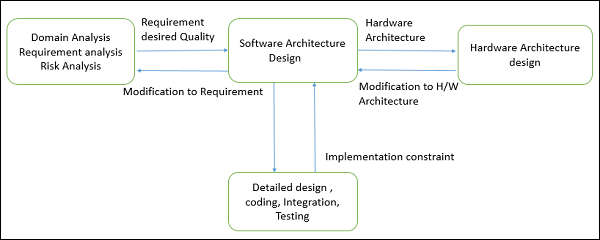Software Architecture
Software Architecture
Architecture serves as a blueprint for a system. It provides an abstraction to manage the system complexity and establish a communication and coordination mechanism among components.
It defines a structured solution to meet all the technical and operational requirements, while optimizing the common quality attributes like performance and security.
Further, it involves a set of significant decisions about the organization related to software development and each of these decisions can have a considerable impact on quality, maintainability, performance, and the overall success of the final product. These decisions comprise of −
Selection of structural elements and their interfaces by which the system is composed.
Behavior as specified in collaborations among those elements.
Composition of these structural and behavioral elements into large subsystem.
Architectural decisions align with business objectives.
Architectural styles guide the organization.
Software Design
Software design provides a design plan that describes the elements of a system, how they fit, and work together to fulfill the requirement of the system. The objectives of having a design plan are as follows −
To negotiate system requirements, and to set expectations with customers, marketing, and management personnel.
Act as a blueprint during the development process.
Guide the implementation tasks, including detailed design, coding, integration, and testing.
It comes before the detailed design, coding, integration, and testing and after the domain analysis, requirements analysis, and risk analysis.

Goals of Architecture
The primary goal of the architecture is to identify requirements that affect the structure of the application. A well-laid architecture reduces the business risks associated with building a technical solution and builds a bridge between business and technical requirements.
Some of the other goals are as follows −
Expose the structure of the system, but hide its implementation details.
Realize all the use-cases and scenarios.
Try to address the requirements of various stakeholders.
Handle both functional and quality requirements.
Reduce the goal of ownership and improve the organization’s market position.
Improve quality and functionality offered by the system.
Improve external confidence in either the organization or system.
https://www.tutorialspoint.com/software_architecture_design/introduction.htm
Software Architecture的更多相关文章
- Agile software architecture design document style..( sketches and no UMLs)
http://www.infoq.com/articles/agile-software-architecture-sketches-NoUML If you're working in an agi ...
- Software Architecture软件架构(方法、模式与框架)纵横谈
Software Architecture软件架构是啥 随着软件行业的发展,软件的规模越来越大,"Software Architecture软件架构"这个名词开始频繁出现.&quo ...
- Software Architecture Pattern(Mark Richards)笔记
软件架构模式 缺少规范架构的程序通常会变得紧耦合.脆弱.难以更改,缺少清晰的发展方向和愿景.这本小书用50多页介绍了常用的5种常见架构模式,相信不管是大牛还是萌新都会有所收获,特别是对我这种偏爱系统设 ...
- 微内核架构(Microkernel Architecture)
微内核架构(Microkernel Architecture) 微内核架构有时也被成为插件架构模式(plug-in architecture pattern),通常用于实现基于产品的应用,如Eclip ...
- Lua 架构 The Lua Architecture
转载自:http://magicpanda.net/2010/10/lua%E6%9E%B6%E6%9E%84%E6%96%87%E6%A1%A3/ Lua架构文档(翻译) 十 102010 前段时间 ...
- Understanding Spring Web Application Architecture: The Classic Way--转载
原文地址:http://www.petrikainulainen.net/software-development/design/understanding-spring-web-applicatio ...
- 敏捷软件工程(agile software development) VS传统软件工程(traditional software development)
敏捷软件工程(agile software development) VS传统软件工程(traditional software development) Agile principle ...
- SAwUML – UML-based, contractual software architectures and their formal analysis using SPIN
一.基本信息 标题:SAwUML – UML-based, contractual software architectures and their formal analysis using SPI ...
- The Architecture of Open Source Applications: Berkeley DB
最近研究内存关系数据库的设计与实现,下面一篇为berkeley db原始两位作为的Berkeley DB设计回忆录: Conway's Law states that a design reflect ...
随机推荐
- Android OpenGL教程-第三课【转】
第三课 给多边形上色: 作为第二课的扩展,我将叫你如何使用颜色.你将理解两种着色模式,在左图中,三角形用的是光滑着色,四边形用的是平面着色. 这次增加的代码不算多. 增加一个color的buffer ...
- VMware Workstation 12激活码
VMware Workstation 12 Pro key/注册码: VY1DU-2VXDH-08DVQ-PXZQZ-P2KV8 VF58R-28D9P-0882Z-5GX7G-NPUTF YG7XR ...
- HTML5坦克大战(韩顺平版本)
HTML5坦克大战(韩顺平版本) 2017-3-22 22:46:22 by SemiconductorKING 去年暑假学习了一下HTML5实现简单的坦克大战,觉得对JavaScript初学者来说, ...
- .net core 第一篇选择开发工具和环境
.net core 已经发布三年了,社区也逐步成熟.作为微软阵营的一员,忙了一年年底抽点时间系统学习下.学习资料主要为以下为主: 1. https://docs.microsoft.com/zh-cn ...
- RabbitMQ - exchange
总结一下几种ExchangeTypes. 之前写发布/订阅模式时第一次提到了exchange type.即producer不是将消息直接放到队列中,而是先到exchange中,exchange主要用于 ...
- 三:Mybatis知识整理(3)
一:mybatis中模糊查询的方法: 1.直接传参法:在java传参时进行拼接 -- %keyword% 2.mysql内置函数:concart('%',#{keyword},'%') -- 拼接sq ...
- redis(9)集群搭建
一.搭建流程 以下我们将构建这样一个redis集群:三个主节点,分别备有一个从节点,主节点之间相互通信,如果主节点挂掉,从节点将被提升为主节点. redis集群至少需要3个redis实例 那么我们需要 ...
- How WindowLeaked exception occured?
If a Activity performDestroy, and there is window not closed whose window token is the Activity's mW ...
- JBPM学习第1篇:入门与安装
1.相关关键词 BPM:全称Business Process Management,即业务流程管理 BPEL:全称为Business Process Execution Language,即业务流程执 ...
- 重构指南 - 分解复杂判断(Remove Arrowhead Antipattern)
当代码中有多层嵌套时,会降低代码的可读性,对于以后的修改也增加难度,所以我们需要分解复杂的判断并尽快返回. 重构前代码 public class Security { public ISecurity ...
